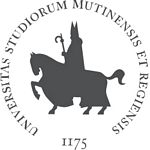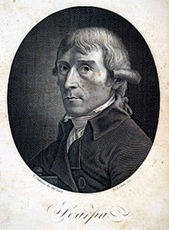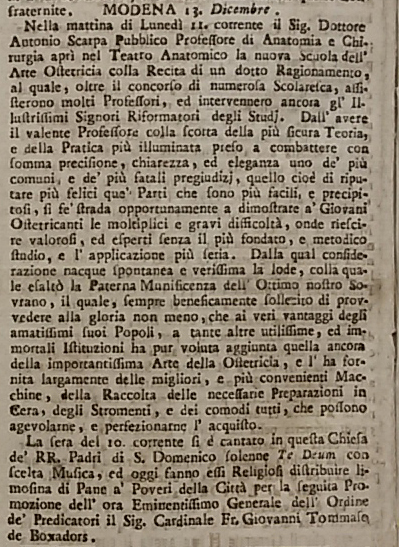Itinerary edited by UNIVERSITY OF MODENA AND R. EMILIA 


Antonio Scarpa was born on the 19th of May 1752 in Motta di Livenza, in the province of Treviso. After the Medicine and Surgery degree in Padua, where he was student of Giovanni Battista Morgagni, in 1772 he was called in Modena (year of University reform by Francesco III) and appointed ordinary professor of Anatomy and Surgery.
The Magistrate of Study Reformers, on the 28th of October 1772, deliberated that the professors had to dress a black moire robe the day of the University opening and during the lessons. Scarpa was exempted from dressing it only during the lessons held in the Anatomy school. The Anatomy lessons took place three times a week (Monday, Wednesday and Friday) from 11 to 12, in a room on the ground floor of the big Sant’Agostino Hospital (it was built thanks to Francesco III between 1753 and 1758), which was put at disposal from the Opera Pia Generale dei Poveri (General Religious Charity of Poor), responsible for the management of the Hospital. The principal of the Medicine Class, Michele Rosa, became interpreter of the Scarpa difficulties during the lessons in that small room. The negotiations for the construction of the new Anatomical Theatre started in this way. It was built in the Big Sant’Agostino Hospital and its internal structure was projected by Antonio Scarpa own.
He was very appreciated by the students for his clearness and order of exposition. A prove of this, from a “Statement of Students, that attend the under noted schools”, dated 4 of May 1773, we find out that the students of Scarpa were 46, while the year later they were never less than one hundred. When Scarpa was old, he told that the applauses, that received in that years, allowed him to bear any hard fatigue.
The second teaching year of Scarpa is characterized by a first increasing of salary decided by Francesco III as reward for the excellent result of the previous year, but also by the awarding of Official Patent that declared him “First Reader in the medical class of Anatomy and Surgery”.
During his studies, Scarpa attended two important Schools of Obstetrics: the one of Bologna and the one of Padua. In XVIII Century, in fact all over the Europe there were a feeling of renewal in the obstetrical field. In this atmosphere, on the 11th of December 1775, Scarpa decided to open “the new school of Obstetrics Art”, as remembered the “Modena Messenger” dated 13th of December.

The Magister of Reformers himself established that the midwives would be instructed in an adequate school, so to ensure a more specialized assistance during the delivery. For this reason he offered to Scarpa all the support so that the school could be opened.
In October 1775, Scarpa asked the Reformers to give instructions for the realization, under his direction, of the wax preparations to be used as demonstrative model for the obstetrics lessons. Already at the beginning of November Scarpa obtained the authorizations and on the 11th of December the Reformers gave him 750 lire to perform the sculptures. Scarpa chose the young sculptor Giovanni Battista Manfredini for this task.
Already in 1776, Scarpa worried about the collocation of the wax preparations, so that these were placed in a more suitable place for the conservation, for this reason he proposed the construction of special shelves. In order to be able to increase the museum, Scarpa urged the Reformers to receive financial supports: during 11 years of Scarpa stay in Modena, the number of the anatomic preparations continued to increase.
As we have already spoken about, starting from the academic year 1775-1776, his course included subjects of obstetrics and from 1777-1778, it adopted the official denomination of chair of Anatomy, Surgery and Obstetrics. He taught in Modena till 1783, when he was called at the Pavia university.
A short time after the erection of the anatomic Theatre, following the death of Olivier, surgeon of the Modena Military Hospital, Scarpa was asked to fulfill his task and to run a course of surgical operations on cadavers.
During his stay in Modena, Scarpa was completely engaged with the teaching and he didn’t find time as consequence for the practical exercise of his profession.
Many and remarkable for importance and contents originality were the works that Scarpa sent to press. His work in the anatomy field was so important that some parts of human body are still named with his name on the international medical nomenclature.
In 1781, he obtained the permission from Ercole III to go to France and to England. Before the departure, he gave disposition that, during his absence (1781-82), the Anatomy course were run by Michele Araldi.
In Paris, he saw the operations performed by Ferrand, surgeon chief by Hōtel-Dieu. Furthermore, Ferrand permitted him to visit the maternity rooms and after having seen twenty-six lithotomies (surgeries for the removal of kidneys calculus), to prove himself under his guidance. He also could see other operations of important masters. As member of the Royal Medicine Society, Scarpa attended the twice-weekly meetings that had place in the Louvre, where he also had the honor to present two memoirs of him: one about aneurism, the other about the detrimental effects of the mercury on the skull bones.
On the 6th of November 1781, he left Paris to go to London, where he arrived a week later. He immediately contacted the anatomist Guglielmo Hunter to ask him the permission to attend the lessons. Hunter not only gave him the permission, but permitted him to attend the lessons free, without paying 6 guinea, settled instead by the other students. Hunter let Scarpa visit his museum, that Scarpa found very interesting and the day later, Hunter donated to Scarpa all his works. The relationship with him was not only as student-professor, but became friendship remembered by Scarpa in the opening lecture of Pavia "Hunterum.., quo etiam amico nuperutebar". Hunter showed him all his studies on lymphatic vessels in birds and fishes and Scarpa intended to revert this studies on the human body. Another reasons why Scarpa went to London, were the improvements occurred there in the field of medical electric machineries. Scarpa was impressed form the beauty of London, that considered superior than the one of Paris. After Oxford, he visited the Essex and Berks counties. In London he also attended the Giovanni Hunter’s lessons, little brother of Guglielmo, who succeeded to transmit him the love for the comparative anatomy. Because of a contagious disease, that struck him a short time before his departure, he was forced to prolong his stay in London.
After his comeback in Italy on the 2nd of September 1782, he started regularly his teaching again. In that period begun the negotiations for his moving to Pavia. During this last year he enriched his lessons with a wide description of absorbent lymphatic vessels, that he learned from Guglielmo Hunter. His last lesson (28 of March 1783), that closed his ten-year teaching at the Modena University, was about this subject.
He always had a good rapport with Alessandro Volta; he studied with professors Girolamo Vandelli and Giovanni Battista Morgagni, whose he became assistant. He kept up a correspondence with two Italian scientists: Lazzaro Spallanzani and Michele Girardi. The exchange of letters with Lazzaro Spallanzani started with serene and cordial tones; afterwards, some disagreements arised. With Girardi, that he met during his period in Padua, since he was prosector of Morgagni, maintained a cordial correspondence.
In 1783, he was called to the Pavia University from the Wien Court under suggestion of Alessandro Brambilla from Pavia. He will stay there till the death, occurred on 1832. In Pavia, his first and principle engagement was the construction of the Anatomic Theatre. He furthermore created a big collection, nowadays preserved in the Historic Museum of the Pavia University. Probably, during the solemn inauguration with Latin oration, he received as gift from Brambilla the beautiful small case made of inlaid mahogany with the collection of instruments for anatomical researches, still conserved in the hall of Scarpa Room.
After his moving, in Modena Michele Araldi was entrusted to run lessons of Anatomy and Medical Institutions, while Paolo Spezzani the ones of Surgery and Obstetrics.
During his stay in Pavia, he was appointed to the chairs of human Anatomy and teaching of surgical operations. In 1787 he was entrusted with the direction Surgical Clinical Medicine. In 1800, he was named President of anatomical laboratory. In 1804, he left both teachings: human Anatomy was appointed to Fattori, while surgerical Clinical Medicine to Volpi. The year later, Napoleone invited him to appoint the two chairs again, that he mantained till 1813, when he retired holding the direction of the medical Faculty and anatomic Laboratories.
Many and remarkable for importance and contents originality were the works that Scarpa sent to press. He established himself as anatomist in 1773 with the publication of his first note De structurafenestraerotundaeauris, et de tympanosecundario, but a more complete statement of his anatomical and anatomy-comparative discoveries about the organ of hearing were published with a rich iconographic documentation in 1789 and with these also the results about the researches on organ of olfaction and on olfactory nerve already announced in a previous work dated 1785. Two years later, he discovered the spinal accessory nerve. Really important was the discovery of the heart nerves, which demonstration directly conflicted with the statement of Behrends dated 1792, that the heart is without nerves. From 1799 to 1804 he made observations of minute structure of bones, osteogenesis, increasing and reabsorption. Starting from 1800, his activity went always more towards surgery; engaging in the exercise and teaching of oculist clinical medicine, he published his masterly work about eyes diseases, followed from other four editions from 1801 to 1816.
Coming back to 1808, is the eminent work furnished with lithographic plates on hernias, whose was published a second edition in 1820 and a supplement on perineum hernias in 1823. Treating the femoral-groin hernias (or crural) and the ligature of the femoral artery in upper third of it, Scarpa gave a precise description of the region that was named triangle of Scarpa and that is nowadays part of international medical nomenclature. Significant is the memoir on cancer and on scirrhus (hard and fibrous carcinoma) dated 1821, translated in English and German in 1822 e printed again in 1825.
Scarpa was for a long time and repeatedly Rector, then, in the last years, Director of Medical Studies and Laboratories. Authoritative and intransigent he had few friends and many antagonists; he was appreciated for his unquestionable value, but feared and even hated.
In the last years of life, and moreover during his disease, perhaps only two pupils were faithful to him, the surgeon Cairoli and Panizza, his successor on the anatomy chair. These persons too seem that abandoned his corpse after having recomposed it, let it watching by a young assistant that took off the head of the master from to bust to conserve it. This relic is still showed in the Museum of the History of the University; nobody knows where are the remains of this illustrious old man, died alone on the 31st of October 1832 in Pavia.
13th June 1747 Antonio Scarpa was born in Lorenzaga di Motta di Livenza (Treviso province)
19th May 1770 Antonio Scarpa graduated in Medicine and Surgery at Padua university. Pupil of Giovan Battista Morgagni, he practised also in Bologna, «in the most important Hospitals of that city»
1772 he was called in Modena to teach Anatomy and Surgery
1773 publication of the first note of Antonio Scarpa De structura fenestrae rotundae auris, et de tympano secundario anatomicae observationes, its first scientific study, a comparative survey on the ear, where he offers a more accurate and complex description of the bony labyrinth and show the true function of the round window of the ear
December 1773 started the works for the Construction of the Anatomic Theatre, that was realized basing on a plan of Lorenzo Toschi
1775 Scarpa opened the School of Obstetric Art, initiative strongly supported by duke Francesco III. Scarpa needed of adequate instruments for the teaching and asked for “artificial preparations of pregnancy, natural delivery and not natural delivery” to the young sculptor Giovan Battista Manfredini from Bologna
1775 The anatomical Theatre was inaugurated with a Scarpa lesson, but the works for his construction ended later
8th November 1775 Scarpa was authorized to pay Giovan Battista Manfredini for the wax anatomical preparations used as model of study for the Obstetrics School
1776 adequate shelves had to be built to preserve the anatomical pieces
1781 he travelled to France and to England
From 1783 Scarpa moved to Pavia, called from Wien Court to occupy the Chair of Surgical Clinical Medicine at the local University. Here, he gave instructions for the construction of an anatomical Theatre
1784 the obstetrics teaching was appointed to Sante Fattori
1785 Ercole III of Este closed the tribunal of the Inquisition of Modena
31st October 1832 Antonio Scarpa died in Pavia
 Pavia
Pavia  Paris
Paris  London
LondonAbbott A. (2008/01/31). Hidden treasures: The University History Museum in Pavia. Nature, 451, 526.
Bilancioni G. (1933). Scarpa e lo studio dei seni accessori del naso. Monitore zoologico italiano, 43(3), p. 45-49.
Capparoni P. (1925). Profili bio-bibliografici di medici e naturalisti celebri italiani: vol. I. Roma: Istituto Nazionale Medico Farmacologico.
Comitato permanente per la storia della Universitą di Modena (1932). Rassegna per la storia della universitą di modena e della cultura superiore modenese : fasc. 4., dedicato a Antonio Scarpa e l'Universitą di Modena; Appendice all'annuario per l'anno accademico 1931-32, 750. dalle origini dello studio, 10. dell'era fascista. Modena: R. Universitą degli Studi.
Corradini E. (2011). Nascita e sviluppo dei Musei Anatomici di Modena tra Settecento e Ottocento: il Museo Ostetrico, il Museo Anatomico, il Museo Etnografico Antropologico. Medicina nei secoli Arte e Scienza, 27(2), p. 441-480.
Corradini E. (2011). Percorsi di valorizzazione per i Musei Anatomici di Modena: il Museo Ostetrico, il Museo Anatomico, il Museo Etnografico Antropologico e il Museo di Medicina Tropicale. Museologia Scientifica, 5(1-2), p. 97-108.
Corradini E., Russo A. (2008). Musei Universitari Modenesi. Bologna: Editrice Moderna.
De Renzi S. (1845-48). Storia della medicina in Italia. Napoli: Dalla tipografia del Filiatre-Sebezio.
Di Palma W. (1991). Descrizione delle cere ostetriche romane di Giovan Battista Manfredini. In Bovi T., Di Palma W., Marri Malacrida L., Le cere ostetriche romane di Giovan Battista Manfredini (p. 35-38). Roma: Quasar.
Di Pietro P. (1977). Preparati in cera nel Museo Anatomico dell’Universitą di Modena. La ceroplastica nella scienza e nell’arte. Atti del I Congresso internazionale, Firenze 3-7 giugno 1975 (p. 299-307). Firenze: L. S. Olschki.
Di Pietro P., Toni G. (1971). L’insegnamento dell’Anatomia nello Studio modenese e l’Istituto di Anatomia Umana Normale. Modena: STEM.
Di Pietro P. (1957). Contributo alla storia degli studi anatomici in Modena. Atti e Memorie Deputazione di Storia Patria per le antiche provincie modenesi, 9, p. 81-87.
Favaro G. (1932). Antonio Scarpa e l'Universitą di Modena (1772-1783). Nuovi contributi alla storia dell'anatomia e della medicina in Modena. Modena: Universitą degli studi.
Fratello B., Maramaldo R., Andreoli S., Tongiorgi P. (2008). Una Collezione settecentesca del Museo di Anatomia dell’Universitą di Modena e Reggio Emilia. I modelli ostetrici realizzati in terracotta da Giovan Battista Manfredini. Museologia Scientifica Memorie, (2), p. 215-220.
Fratello B., Maramaldo R. (2005). I musei Anatomici dell’Universitą di Modena e Reggio Emilia. Atti della Societą dei Naturalisti e Matematici di Modena, p. 37-43.
Momesso S. (2007), La collezione di Antonio Scarpa (1752-1832). Cittadella: Bertoncello artigrafiche.
Münster L. (1932). Antonio Scarpa. Progressi di terapia, (12).
Scarenzio L. (1832). Cenni sulla vita e sulle opere del cav. Antonio Scarpa, Biblioteca Ital. Milano.
Testi F. (1939). In memoria del prof. Giuseppe Franchini: adunanza 11 aprile 1939. Atti e Memorie della Reale Accademia di Scienze lettere e Ari di Modena, 4, p. 46-52.
Universitą di Pavia (n. d.). Pavia Project Physics. Museo per la Storia dell’Universitą: sezione di Medicina. Tratto da http://ppp.unipv.it/Museo/Pagine/Medicina/Medicina.htm.
Vaccą L. (1872). Cenno Storico della R. Universitą di Modena e delle sue dipendenze. Modena: Tipografia Cappelli.
Vannoni P. (1836). Opere del cav. Antonio Scarpa. Firenze: Tipografia e Calcografia della Speranza.
Viana O., Vozza F. (1933). L’Ostetricia e la Ginecologia in Italia. Milano: Societą italiana di ostetricia e ginecologia.